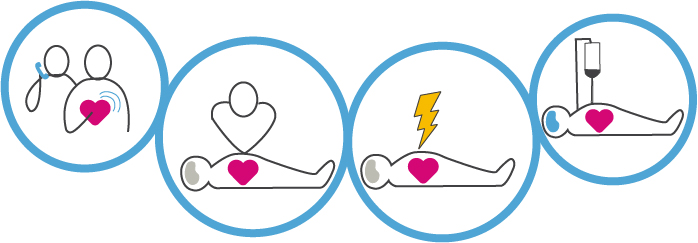Prehospital Treatment of Heart Attack
The time between the onset of symptoms and arriving at the hospital is critical for successfully treating a heart attack. This phase is known as the “prehospital phase,” and is influenced by various factors.
What happens in a heart attack?
How is the prehospital phase divided?
How strongly can a patient influence his chance of recovery?
What happens during the prehospital treatment time?
Why is it so important to receive treatment for a heart attack quickly?

What happens in a heart attack?
With a heart attack, a coronary artery is blocked leading to an insufficient supply of oxygen. This causes the heart muscle in the affected region to irreversibly die. The dead tissue forms a scar, and patients live with decreased cardiac function (coronary insufficiency). In certain situations, arrhythmias (i.e. ventricular fibrillation) arise, which can cause death. Rapid intervention, when possible within the first 60 minutes after the vessel fully closes, can prevent negative side effects or worsening of the already-occurred damage. This period of time is known as the „golden hour.“
Unfortunately, many ignore or minimize their symptoms in order to not burden their environment. Valuable time passes. Heart attack is the most common cause of death before reaching the hospital, responsible for 55,000 deaths yearly in Germany.
The highest potential to lower the infarct mortality rate lies in the prehospital phase.
How is the prehospital phase divided?
The prehospital phase is influenced by various factors, with the interaction between patients, relatives and emergency medical personnel being complex. The time delay between when symptoms present and when definitive treatment starts can be divided into patient decision-making time, prehospital treatment time and intrahospital delay.
How strongly can a patient influence his chance of recovery?
The patient decision-making time includes the time between when symptoms present and when he contacts a physician or emergency medical personnel. The greatest time delay is due uncertainty of individuals. Confusion about one’s own symptoms leads to a delay in contacting emergency medical personnel. Sound knowledge about heart attack symptoms can lead to a life-saving time benefit.
According to the MEDEA study* from Munich, 486 heart attack patients were examined, which showed: men with prior knowledge of heart attack waited 168 minutes on average to seek medical attention, in comparison to 276 minutes for those without prior knowledge. For women, those with prior knowledge took, on average, 189 minutes, in comparison to 262 minutes. The bottom line of the study: heart attack patients with sufficient prior knowledge about infarct symptoms have a 50 percent higher chance of reaching the hospital earlier than individuals without prior knowledge.
Bystanders are also often unable to properly evaluate symptoms. For this reason, extensive education for relatives of patients at high risk is of great importance. Additionally, individuals often first contact their general practitioner, leading to an additional time delay.
What happens during the prehospital treatment time?
The prehospital treatment time begins when emergency medical personnel arrive and ends when reaching the hospital. In an ideal situation, the emergency medical personnel are specialised in early treatment of infarcts. When this is the case, a full examination and cardiac enzyme tests are performed. Infarct-specific enzymes first rise after a few hours, so it is often the case that a definitive diagnosis is unable to be made in an ambulance using this method. The quickest and most effective option for recognizing an infarct is by performing a complete 12-lead ECG. This method of diagnosis allows for the recognition of a suspected ST-elevation myocardial infarction (STEMI) in patients with heart attack symptoms. The reliability of the diagnosis is greater than 95 percent. Patients can already receive medication as initial treatment. If the suspicion of a heart attack is confirmed, the emergency medical technician immediately contacts the hospital. In the best-case scenario, the cardiac catheterization lab is immediately available when the ambulance arrives. Intrahospital delay occurs when emergency physicians were not able to generate a conclusive diagnosis before reaching the hospital. More examinations and tests then have to be performed before the blocked coronary artery can be reopened. Precious time passes.
Why is it so important to receive treatment for a heart attack quickly?
According to the European Society of Cardiology (ESC), timing is decisive. ESC guidelines recommend an ECG being recorded within 10 minutes of contact with emergency medical personnel, and for percutaneous coronary intervention (PCI) to be initiated within 60 minutes of reaching the hospital in order to have the best outcome possible. ** Any delay in medical treatment should be avoided at all costs.
In order to overcome the uncertainty associated with symptoms, individuals can use a mobile ECG system. It is very important to note, that a mobile ECG should have at least 12 leads in order to be able to detect a heart attack. CardioSecur is a mobile 15-lead ECG that makes this possible. We explain to you why it is important to regularly check your heart and how it works.
Studies using CardioSecur have shown that:
- Physicians view the use as excellent
- The additional leads make it possible to visualize previously overlooked STEMIs
- The treatment pathway for patients and hospitals can be improved
* L. Albarqouni, et al./ Patients’ knowledge about symptoms and adequate behaviour during acute myocardial infarction and its impact on delay time, Patient Educ Couns (2016). idw-online.de/de/news659971